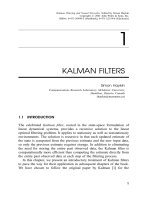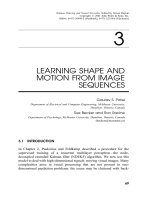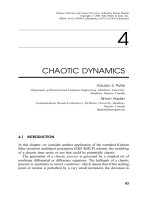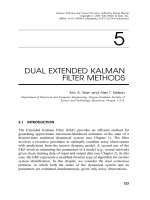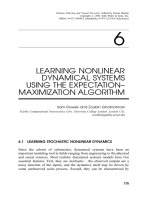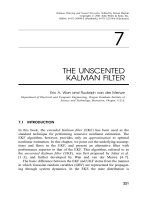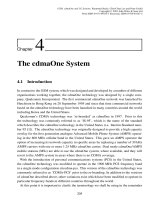Tài liệu Kalman Filtering and Neural Networks P4 doc
Bạn đang xem bản rút gọn của tài liệu. Xem và tải ngay bản đầy đủ của tài liệu tại đây (872.98 KB, 40 trang )
4
CHAOTIC DYNAMICS
Gaurav S. Patel
Department of Electrical and Computer Engineering, McMaster University,
Hamilton, Ontario, Canada
Simon Haykin
Communications Research Laboratory, McMaster University, Hamilton,
Ontario, Canada
()
4.1 INTRODUCTION
In this chapter, we consider another application of the extended Kalman
filter recurrent multilayer perceptron (EKF-RMLP) scheme: the modeling
of a chaotic time series or one that could be potentially chaotic.
The generation of a chaotic process is governed by a coupled set of
nonlinear differential or difference equations. The hallmark of a chaotic
process is sensitivity to initial conditions, which means that if the starting
point of motion is perturbed by a very small increment, the deviation in
83
Kalman Filtering and Neural Networks, Edited by Simon Haykin
ISBN 0-471-36998-5 # 2001 John Wiley & Sons, Inc.
Kalman Filtering and Neural Networks, Edited by Simon Haykin
Copyright # 2001 John Wiley & Sons, Inc.
ISBNs: 0-471-36998-5 (Hardback); 0-471-22154-6 (Electronic)
the resulting waveform, compared to the original waveform, increases
exponentially with time. Consequently, unlike an ordinary deterministic
process, a chaotic process is predictable only in the short term.
Specifically, we consider five data sets categorized as follows:
The logistic map, Ikeda map, and Lorenz attractor, whose dynamics
are governed by known equations; the corresponding time series can
therefore be numerically generated by using the known equations of
motion.
Laser intensity pulsations and sea clutter (i.e., radar backscatter from
an ocean surface) whose underlying equations of motion are
unknown; in this second case, the data are obtained from real-life
experiments.
Table 4.1 shows a summary of the data sets used for model validation.
The table also shows the lengths of the data sets used, and their division
into the training and test sets, respectively. Also shown is a partial
summary of the dynamic invariants for each of the data sets used and
the size of network used for modeling the dynamics for each set.
4.2 CHAOTIC (DYNAMIC) INVARIANTS
The correlation dimension is a measure of the complexity of a chaotic
process [1]. This chaotic invariant is always a fractal number, which is one
reason for referring to a chaotic process as a ‘‘strange’’ attractor. The other
Table 4.1 Summary of data sets used in the study
Network
size
Training
length
Testing
length
Sampling
frequency
f
s
ðHzÞ
Largest
Lyapunov
exponent
l
max
(nats=sample)
Correlation
dimension
D
ML
Logistic 6-4R-2R-1 5,000 25,000 1 0.69 1.04
Ikeda 6-6R-5R-1 5,000 25,000 1 0.354 1.51
Lorenz 3-8R-7R-1 5,000 25,000 40 0.040 2.09
NH
3
laser 9-10R-8R-1 1,000 9,000 1
a
0.147 2.01
Sea clutter 6-8R-7R-1 40,000 10,000 1000 0.228 4.69
a
The sampling frequency for the laser data was not known. It was assumed to be 1 Hz for the
Lyapunov exponent calculations.
84
4 CHAOTIC DYNAMICS
chaotic invariants, the Lyapunov exponents, are, in part, responsible for
sensitivity of the process to initial conditions, the occurrence of which
requires having at least one positive Lyapunov exponent. The horizon of
predictability (HOP) of the process is determined essentially by the largest
positive Lyapunov exponent [1]. Another useful parameter of a chaotic
process is the Kaplan–York dimension or Lyapunov dimension, which is
defined in terms of a Lyapunov spectrum by
D
KY
¼ K þ
P
K
i¼1
l
i
jl
Kþ1
j
; ð4:1Þ
where the l
i
are the Lyapunov exponents arranged in decreasing order and
K is the largest integer for which the following inequalities hold
P
K
i¼1
l
i
! 0 and
P
Kþ1
i¼1
l
i
< 0:
Typically, the Kaplan–Yorke dimension is close in numerical value to the
correlation dimension. Yet another byproduct of the Lyapunov spectrum is
the Kolmogorov entropy, which provides a measure of information
generated due to sensitivity to initial conditions. It can be calculated as
the sum of all the positive Lyapunov exponents of the process. The chaotic
invariants were estimated as follows:
1. The correlation dimension was estimated using an algorithm based
on the method of maximum likelihood [2] – hence the notation D
ML
for the correlation dimension.
2. The Lyapunov exponents were estimated using an algorithm, invol-
ving the QR - decomposition applied to a Jacobian that pertains to
the underlying dynamics of the time series.
3. The Kolmogorov entropy was estimated directly from the time series
using an algorithm based on the method of maximum likelihood
[2] – hence the notation KE
ML
for the Kolmogorov entropy so
estimated. The indirect estimate of the Kolmogorov entropy from
the Lyapunov spectrum is denoted by KE
LE
.
4.2 CHAOTIC (DYNAMIC) INVARIANTS
85
4.3 DYNAMIC RECONSTRUCTION
The attractor of a dynamical system is constructed by plotting the
evolution of the state vector in state space. This construction is possible
when we have access to every state variable of the system. In practical
situations dealing with dynamical systems of unknown state-space equa-
tions, however, all that we have available is a set of measurements taken
from the system. Given such a situation, we may raise the following
question: Is it possible to reconstruct the attractor of a system (with many
state variables) using a single time series of measurements? The answer to
this question is an emphatic yes; it was first illustrated by Packard et al.
[3], and then given a firm mathematical foundation by Takens [4] and
Man˜e
´
[5]. In essence, the celebrated Takens embedding theorem guaran-
tees that by applying the delay coordinate method to the measurement
time series, the original dynamics could be reconstructed, under certain
assumptions. In the delay coordinate method (sometimes referred to as the
method of delays), delay coordinate vectors are formed using time-delayed
values of the measurements, as shown here:
sðnÞ¼½sðnÞ; sðn À tÞ; ...; sðn Àðd
E
À 2ÞtÞ; sðn Àðd
E
À 1ÞtÞ
T
;
where d
E
is called the embedding dimension and t is known as the
embedding delay, taken to be some suitable multiple of the sampling time
t
s
. By means of such an embedding, it is possible to reconstruct the true
dynamics using only one measurement. Takens’ theorem assumes the
existence of d
E
and t such that mapping from sðnÞ to sðn þ tÞ is possible.
The concept of dynamic reconstruction using delay coordinate embedding
is very elegant, because we can use it to build a model of a nonlinear
dynamical system, given a set of measured data on the system. We can use
it to ‘‘reverse-engineer’’ the dynamics, i.e., use the time series to deduce
characteristics of the physical system that was responsible for its genera-
tion. Put it another way, the reconstruction of the dynamics from a time
series is in reality an ill-posed inverse problem. The direct problem is:
given the dynamics, describe the iterates; and the inverse problem is: given
the iterates, describe the dynamics. The inverse problem is ill-posed
because, depending on the quality of the data, a solution may not be
stable, may not be unique, or may not even exist. One way to make the
problem well-posed is to include prior knowledge about the input–output
mapping. In effect, the use of delay coordinate embedding inserts some
prior knowledge into the model, since the embedding parameters are
determined from the data.
86
4 CHAOTIC DYNAMICS
To estimate the embedding delay t, we used the method of mutual
information proposed by Fraser [6]. According to this method, the
embedding delay is determined by finding the particular delay for which
the mutual information between the observable time series and its delayed
version is minimized for the first time. Given such an embedding delay, we
can construct a delay coordinate vector whose adjacent samples are as
statistically independent as possible.
To estimate the embedding dimension d
E
, we use the method of false
nearest neighbors [1]; the embedding dimension is the smallest integer
dimension that unfolds the attractor.
4.4 MODELING NUMERICALLY GENERATED CHAOTIC
TIME SERIES
4.4.1 Logistic Map
In this experiment, the EKF-RMLP-based modeling scheme is applied to
the logistic map (also known as the quadratic map), which was first used
as a model of population growth. The logistic map is described by the
difference equation:
xðk þ 1Þ¼axðkÞ½1 À xðkÞ; ð4:2Þ
where the nonlinearity parameter a is chosen to be 4.0 so that the
produced behavior is chaotic. The logistic map exhibits deterministic
chaos in the interval a 2 (3.5699, 4]. An initial value of xð0Þ¼0:5was
used, and 35,000 points were generated, of which the first 5000 points
were discarded, leaving a data set of 30,000 samples. A training set,
consisting of the first 5000 samples, was used to train an RMLP on a one-
step prediction task by means of the EKF method. An RMLP configura-
tion of 6-4R-2R-1, which has a total of 61 weights including the bias
terms, was selected for this modeling problem. The training converged
after only 5 epochs and a sufficiently low MSE was achieved as shown in
Figure 4.1.
Open-Loop Evaluation A test set, consisting of the unexposed
25,000 samples, was used to evaluate the performance of the network at
the task of one-step prediction as well as recursive prediction. Figure 4.2a
shows the one-step prediction performance of the network on a short
portion of the test data. It is visually observed that the two curves are
4.4 MODELING NUMERICALLY GENERATED CHAOTIC TIME SERIES
87
almost identical. Also, for numerical one-step performance evaluation,
signal-to-error ratio (SER) is used. This measure, expressed in decibels, is
defined by
SER ¼ 10 log
10
MSS
MSE
; ð4:3Þ
where MSS is the mean-squared value of the actual test data and MSE is
the mean-squared value of the prediction error at the output. MSS is found
to be 0.374 for the 25,000-testing sequence and MSE is found to be
1:09 Â 10
À5
for the trained RMLP network prediction error. This gives an
SER of 45.36 dB, which is certainly impressive because it means that the
power of the one-step prediction error over 25,000 test samples is many
times smaller than the power of the signal.
Closed-Loop Evaluation To evaluate the autonomous behavior of
the network, its node outputs are first initialized to zero, it is then seeded
with points selected from the test data, and then passed through a priming
phase where it operates in the one-step mode for p
l
¼ 30 steps. At the end
of priming, the network’s output is fed back to its input, and autonomous
Figure 4.1 Training MSE versus epochs for the logistic map.
88
4 CHAOTIC DYNAMICS
Figure 4.2 Results for the dynamic reconstruction of the logistic map. (a) One-step
prediction. (b) Iterated prediction. (c) Attractor of original signal. (d) Attractor of
iteratively reconstructed signal.
89
operation begins. At this point, the network is operating on its own
without further inputs, and the task that is asked of the network is indeed
challenging. The autonomous behavior of the network, which begins after
priming, is shown in Figure 4.2b, and it is observed that the predictions
closely follow the actual data for about 5 steps on average [which is close
to the theoretical horizon of predictability (HOP) of 5 calculated from the
Lyapunov spectrum], after which they start to deviate significantly. Figure
4.3 plots the one-step prediction of the logistic map for three different
starting points
The overall trajectory of the predicted signal, in the long term, has a
structure that is very similar to the actual logistic map. The similarity is
clearly seen by observing their attractors, which are shown in Figures 4.2c
and 4.2d. For numerical autonomous performance evaluation, the dyna-
mical invariants of both the actual data and the model-generated data are
compared in Table 4.2. For the logistic map, d
L
¼ 1; it therefore has only
one Lyapunov exponent, which happens to be 0.69 nats=sample. This
means that the sum of Lyapunov exponents is not negative, thus violating
one of the conditions in the Kaplan–Yorke method, and it is for this reason
that the Kaplan–Yorke dimension D
KY
could not be calculated. However,
by comparing the other calculated invariants, it is seen that the Lyapunov
exponent and the correlation dimension of the two signals are in close
agreement with each other. In addition, the Kolmogorov entropy values for
the two signals also match very closely. The theoretical horizons of
predictability of the two signals are also in agreement with each other.
These results demonstrate very convincingly that the original dynamics
have been accurately modeled by the trained RMLP. Furthermore, the
robustness of the model is tested by starting the predictions from various
locations on the test data, corresponding to indices of N
0
¼ 3060, 5060,
and 10,060. The results, shown in Figure 4.4, clearly indicate that the
RMLP network is able to reconstruct the logistic series beginning from
any location, chosen at random.
Table 4.2 Comparison of chaotic invariants of logistic map
KE
LE
KE
ML
l
1
Time series d
E
t d
L
D
ML
D
KY
(nats=sample) (nats=sample) HOP
(samples)
Actual logistic 6 5 1 1.04 —
a
0.69 0.69 0.64 5
Reconstructed 6 12 1 1.00 —
a
0.61 0.61 0.65 6
a
Since the sum of Lyapunov exponents is not negative, D
KY
could not be calculated.
90
4 CHAOTIC DYNAMICS
4.4.2 Ikeda Map
This second experiment uses the Ikeda map (which is substantially more
complicated than the logistic map) to test the performance of the EKF-
RMLP modeling scheme. The Ikeda map is a complex-valued map and is
generated using the following difference equations:
mðkÞ¼0:4 À
6:0
1 þ x
2
1
ðkÞþx
2
2
ðkÞ
; ð4:4Þ
x
1
ðk þ 1Þ¼1:0 þ mfx
1
ðkÞ cos½mðkÞ À x
2
ðkÞ sin½mðkÞg; ð4:5Þ
x
2
ðk þ 1Þ¼1:0 þ mfx
1
ðkÞþx
2
ðkÞ cos½mðkÞg; ð4:6Þ
where x
1
and x
2
are the real and imaginary components, respectively, of x
and the parameter m is carefully chosen to be 0.7 so that the produced
behavior is chaotic. The initial values of x
1
ð0Þ¼0:5 and x
2
ð0Þ¼0:5 were
selected and, as pointed out earlier, a data set of 30,000 samples was
Figure 4.3 One-step prediction of logistic map from different starting
points. Note that A ¼ initialization and B ¼ one-step phase.
4.4 MODELING NUMERICALLY GENERATED CHAOTIC TIME SERIES
91
generated. In this experiment, only the x
1
component of the Ikeda map is
used, for which the embedding parameters of d
E
¼ 6 and t ¼ 10 were
determined. The first 5000 samples of this data set were used to train an
RMLP with the EKF algorithm at one-step prediction. During training, a
truncation depth t
d
¼ 10 was used for the backpropagation through-time
(BPTT) derivative calculations. The RMLP configuration of 6-6R-5R-1,
which has a total of 144 weights including the bias terms, was chosen to
model the Ikeda series. The training converged after only 15 epochs, and a
sufficiently low incremental training mean-squared error was achieved, as
shown in Figure 4.5.
Open-Loop Evaluation The test set, consisting of the unexposed
25,000 samples of data, is used for performance evaluation, and Figure
4.6a shows one-step performance of the network on a short portion of the
test data. It is indeed difficult to distinguish between the actual and
predicted signals, thus visually verifying the goodness of the predictions.
Figure 4.4 Iterative prediction of logistic map from different starting points,
corresponding to N
0
¼ 3060, 5060, and 10,060, respectively, with p
l
¼ 30.
Note that A ¼ initialization, B ¼ priming phase, and C ¼ autonomous phase.
92
4 CHAOTIC DYNAMICS
For a numerical measure, the mean-squared value of the 25,000 sample
Ikeda test series was calculated to be MSS ¼ 0:564 and the mean-squared
prediction error of MSE ¼ 1:4 Â 10
À4
was produced by the trained
RMLP network, thus giving an SER of 36.02 dB.
Closed-Loop Evaluation To begin autonomous prediction, a delay
vector consisting of 6 taps spaced by 10 samples apart is constructed as
dictated by the embedding parameters d
E
and t. The RMLP is initialized
with a delay vector, constructed from the test samples, and passed through
a priming phase with p
l
¼ 60, after which the network operates in closed-
loop mode. The autonomous continuation from where the training data
end is shown in Figure 4.6b. Note that the predictions follow closely for
about 10 steps on average, which is in agreement with the theoretical
horizon of predictability of 11 calculated by from the Lyapunov spectrum.
A length of 25,000 autonomous samples were generated using the trained
EKF-RMLP model, and the reconstructed attractor is plotted in Figure
4.6d. The reconstructed attractor has exactly the same form as the original
attractor, which is plotted in Figure 4.6c using the actual Ikeda samples.
These figures clearly demonstrate that the RMLP network has captured the
underlying dynamics of the Ikeda map series. For numerical performance
Figure 4.5 Training MSE versus epochs for the Ikeda map.
4.4 MODELING NUMERICALLY GENERATED CHAOTIC TIME SERIES
93
Figure 4.6 Results for the dynamic reconstruction of the Ikeda map. (a) One-step
prediction. (b) Iterated prediction. (c) Attractor of original signal. (d) Attractor of
iteratively reconstructed signal.
94
evaluation, the correlation dimension, Lyapunov exponents and Kolmo-
gorov entropy of both the actual Ikeda series and the autonomously
generated samples are calculated. Table 4.3, which summarizes the results,
shows that the dynamic invariants of both the actual and reconstructed
signals are in very close agreement with each other. This illustrates that the
true dynamics of the data were captured by the trained network. Figure 4.7
plots the one-step prediction of the Ikeda map for three different starting
points. The reconstruction produced here is robust and stable, regardless
of the position of the initializing delay vector on the test data, as
demonstrated in Figure 4.8, which shows autonomous operation starting
at indices of N
0
¼ 3120, 10,120, and 17,120, respectively.
Noisy Ikeda Series It was shown above that the noise-free Ikeda
series can be modeled by the RMLP scheme. In a real environment,
observables signals are usually corrupted by additive noise, which makes
the problem more difficult. Thus, to make the modeling task more
challenging than it already is, computer-generated noise is added to the
Ikeda series such that the resulting signal-to-noise ratios (SNRs) of two
sets of the noisy observables signals are 25 dB and 10 dB, respectively.
Figure 4.7 One-step prediction of Ikeda series from different starting points.
Note that A ¼ initialization and B ¼ one-step phase.
4.4 MODELING NUMERICALLY GENERATED CHAOTIC TIME SERIES
95
The attractors of the noisy signals are shown in the left-hand parts of
Figures 4.9a and 4.9b, respectively. The increase in noise level was more
substantial for the 10 dB case, and this corrupted the signal very
significantly. It is apparent from Figure 4.9b that the intricate details of
the attractor trajectories are lost owing to the high level of noise.
The noisy signals were used to train two distinct 6-6R-5R-1 networks
using the first 5000 samples in the same fashion as in the noise-free case.
The right-hand plots of Figures 4.9a and 4.9b show the attractors of the
autonomously generated Ikeda series produced by the two trained RMLP
networks. Whereas the network trained with a 25 dB SNR was able to
capture the Ikeda dynamics, the network trained with a 10 dB SNR was
unable to do so. This shows that because of the substantial amount of
noise in the 10 dB case, the network was unable to capture dynamics of the
Ikeda series. However, for the 25 dB case, the network was not only able
to capture the predictable part of the Ikeda series but also filtered the
noise. Table 4.3 displays the chaotic invariants of the original and
Figure 4.8 Iterative prediction of Ikeda series from different starting points,
corresponding to indices of N
0
¼ 3120, 10,120 and 17,120, respectively, with
p
l
¼ 60. Note that A ¼ initialization, B ¼ priming phase and C ¼ auto-
nomous phase.
96
4 CHAOTIC DYNAMICS
Table 4.3 Comparison of chaotic invariants of Ikeda map under noiseless and noisy conditions
l
1
l
2
l
3
l
4
l
5
l
6
KE
LE
KE
ML
HOP
Time series d
E
t d
L
D
ML
D
KY
(nats=sample) (nats=sample) (samples)
Actual Ikeda 6 10 2 1.51 1.44 0.354 À 0.802 ————0.354 0.316 11
Reconstructed 6 19 2 1.68 1.33 0.248 À 0.736 ————0.248 0.347 16
25 dB SNR Ikeda 6 1 5 1.92 3.9 0.354 0.076 À0.081 À 0.296 À0.765 — 0.3548 0.314 14
Reconstructed 6 15 3 1.54 2.15 0.248 À 0.14 À0.792 ———0.262 0.304 15
10 dB SNR Ikeda 6 6 6 3.46 —
a
1.145 0.948 0.778 0.543 0.215 0.495 0.363 0.662 3
Reconstructed 6 2 3 0.26 —
a
À3.47 À 6.01 À 3.47 ————
a
—
a
—
a
a
Quantities that could not be calculated.
97
reconstructed signals for both levels of noise. The addition of noise has the
effect of increasing the number of active degrees of freedom, and thus the
number of Lyapunov exponents increases in a corresponding way. The
invariants of the reconstructed signal corresponding to the 25 dB SNR
case match more closely with the original noise-free Ikeda invariants as
compared with the noisy invariants. However, for the failed reconstruction
in the 10 dB case, there is a large disagreement between the reconstructed
invariants and the actual invariants, which is to be expected. In fact, some
of the invariants could not even be calculated.
Figure 4.9 Dynamic reconstruction of the noisy Ikeda map. (a) Autono-
mous performance for Ikeda map with 25 dB SNR. (b) Autonomous perfor-
mance for Ikeda map with 10 dB SNR. Plots on the left to noisy original
signals, and those on the right to reconstructed signals.
98
4 CHAOTIC DYNAMICS
